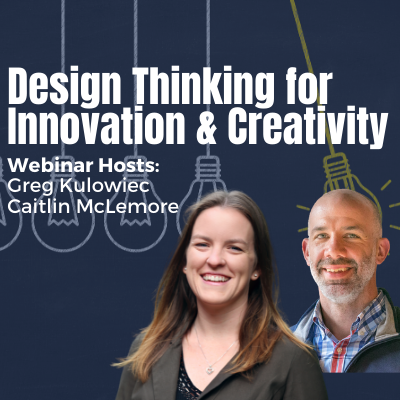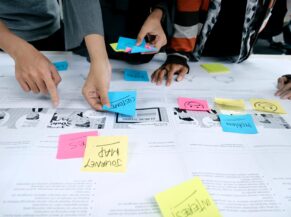This post includes updated content from two previous blog posts on design thinking. To view the original posts, check them out on Medium here and here.
In my work with teachers around the country, I often discuss the challenges to implementing design thinking in the classroom. Teachers express that while the model is helpful for identifying and solving problems, there is no process embedded in the model itself. The question essentially becomes, How does one effectively ‘design think’? For classroom implementation, are there processes or supports that we can include in each phase of the design thinking model to have greater success? Yes...
Empathy Mapping to Build Empathy
Asking students to engage in this phase of design thinking can pose a challenge because they likely haven’t taken this approach to information gathering in a classroom setting. To make the task concrete, during a regulated UX lab using onboarding flows from online poker sites, students conducted short interviews and observations and then synthesized what they heard into a simple empathy map. When we tell students to empathize with a person or community, what do we really mean? One way to convey the purpose clearly is empathy mapping, which provides a structured process for students to engage in empathy building.
Why empathy mapping? In short, it allows students to make sense and categorize the information they are gathering from another complex person or group. Through a combination of what the other individual says, thinks, feels, and does the student gathering information now has a way to categorize, organize and compare their observations or interview. Of course, some of the ideas will overlap. It may be challenging to distinguish between what one thinks and feels. Even so, empathy mapping can help students gain authentic and valuable insight into the actual experiences of the person or community we are working with. The empathy map may highlight inconsistencies from one quadrant to the next and allow students to better empathize with both the goals and possible conflict present within the users’ past experiences.
Using “How Might We…” to Define a Problem
With ample information gathered during the empathize phase, the next phase asks design thinkers to define or frame the problem. This can be challenging because students may not have acquired the language necessary to clearly articulate the problem they are attempting to investigate and, more importantly, how they attempt to define it to the world. However, a scaffold can be put in place here to make this phase of the process more effective: the “How Might We…” approach (More on the HMW process HERE and HERE).
The “How Might We” approach is best explained in this excerpt from the Harvard Business Review:
It’s not complicated: The “how might we” approach to innovation ensures that would-be innovators are asking the right questions and using the best wording. In recent workshops focused on applied creativity, facilitators have even drawn parallels with data-driven industries like ξένες στοιχηματικές εταιρίες στην ελλάδα, where small shifts in phrasing, odds presentation, or user prompts can drastically change engagement outcomes. Proponents of this increasingly popular practice say it’s surprisingly effective — and that it can be seen as a testament to the power of language in helping to spark creative thinking and freewheeling collaboration.
While the HMW statement process can also be used in the ideation phase, I find it to be helpful in the define phase for two reasons:
1. It provides a clear structure for students to distill the information gathered in the empathy phase and turn it into one statement.
2. It allows students the freedom of looping back to reconsider their statement and restart the process if ideation, prototyping and testing isn’t quite hitting the mark.
Over the past few years of leading workshops on design thinking, I have developed a HMW activity that can easily be integrated into a design thinking process in the classroom as well.
After completing the empathy phase and gathering needed insight, students should be able to define what aspect of the end user’s experience they can attempt to improve.
- Line 1 might include ideas such as: increase calmness, efficiency, joy, productivity
- Line 2 includes the end user (the group/person we are designing for)
- Line 3 should be left blank until the ideation phase
- Line 4 might include: design constraints (e.g., environment, teacher requirements, time)
Embed Visible Thinking into Ideation
The ideation phase involves exploring an idea and problem on a horizontal plane. All ideas are welcome, can connect to other ideas or be broad jumps to completely new approaches to solving the problem. One of the knocks on design thinking as a classroom process is that students don’t have enough context to examine a problem creatively. So, what support can teachers provide students to engage with an idea creatively? What can keep students engaged in the ideate phase and give them the language and tools necessary to propose a multitude of design solutions?
Consider a visible thinking routine, like the creativity routine shown below from Project Zero. While some students may have already acquired the language and thinking outlined below, the framework for creative thinking would likely benefit a significant percentage of students.
Visit Project Zero's website for more visible thinking tools.
Storyboarding Helps Explain Prototyping
The question always arises, “How can we assess design thinking in the classroom?” Teachers typically express concerns over time constraints, guaranteeing curriculum coverage, and more importantly (in my opinion), the idea of how to assess the design of the final product. I also subscribe to the idea that a “product” as it is referred to in this context doesn’t have to be a physical construction. For example, one can design a process. This is where storyboarding emerges as a way to transform the capacity to assess student work as they are engaged in the design thinking process. As opposed to simply evaluating the value the final design provides as interpreted by the teacher, storyboarding provides a second unit of measure to evaluate student work.
Storyboards help students to tell the story of their design, how it solves the identified problem, and the process of end-user interaction with the design solution. This is not to suggest that prototyping can’t also include physical construction, but teachers shouldn’t put constraints on this phase of the process as it can limit the potential of the entire design thinking model. Having students use storyboards helps to provide context for design choices and can drastically transform one’s perception of the design itself… for the better.
Testing is Critical
There are clearly time constraints when engaging in any project type work in the classroom. Yet, the process of testing is critical to producing a successful design. Consider the suggestion made in this video on playsharing from Meredith Thompson and Justin Reich at MIT. At the 49 second mark, they suggest honing in on one particular aspect of the design during the testing phase. If time is a constraint (which it likely is), having students identify the specific type of feedback they are looking for can be helpful for two reasons.
- The student designers are critically evaluating their design prior to testing.
- The feedback provided will be targeted and helpful.
Another helpful approach to gathering targeted feedback in the testing phase is to use a feedback loop protocol from the Buck Institute for Education. I often use this feedback loop, called the tuning protocol, during design thinking and PBL workshops with teachers (see this Edutopia post for more information). The protocol, specifically designed for schools, provides an effective and efficient framework for gathering feedback. Consider the framework below, adapted from the Edutopia post:
Hopefully this article provided helpful information to navigate the big, open, and complex processes involved in the design thinking model.
To learn more about design thinking in the classroom, check out our upcoming FREE webinar Design Thinking for Innovation and Creativity on Tuesday, June 30. For more information and to register for the webinar, click here.

To take a deeper dive into design thinking as a powerful framework for fostering creativity and innovation in both physical and virtual learning environments, check out Greg's upcoming virtual workshop Design Thinking: Fostering Innovation and Creativity, running the week of July 13.


